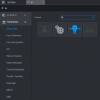Glad our suggestions helped.
Ok - the default settings is your problem. It is clear the laser is working cause that is bright even on auto settings!
Take it off auto settings at night unless you like seeing Casper and blurring and hotspots. Auto settings in most situations for shutter will produce a great picture, but motion is complete crap with blurring and ghosting.
Go into shutter settings and change to manual and start with custom shutter as ms and change to 0-8.3ms and gain 0-50 for starters. Auto could have a shutter speed of 100ms or more and gain up at 100 which will contribute to significant ghosting and that blinding white you are getting from the laser.
Now what you will notice that happens immediately is your image gets A LOT darker. That faster the shutter, the more light that is needed. But it is a balance. The nice bright night image results in Casper during motion LOL. What do we want, a nice static image or a clean image when there is motion introduced to the scene?
So if it is too dark, then start adding ms to the time. Go to 10ms, 12ms, etc. until you find what you feel is acceptable as an image. Then have someone walk around and see if you can get a clean shot. Try not to go above 30ms as that tends to be the point where blur starts to occur.
You can also adjust brightness and contrast to improve the image.
You can also add some gain to brighten the image - but the higher the gain, the more ghosting you get. Some cameras can go to 70 or so before it is an issue and some can't go over 50.
But adjusting those two settings will have the biggest impact. The next one is noise reduction. Want to keep that as low as possible. Depending on the amount of light you have, you might be able to get down to 40 or so at night (again camera dependent), but take it as low as you can before it gets too noisy. Again this one is a balance as well. Too smooth and no noise can result in soft images.
Turn PFA off as that tends to not work as well at night.
Try Illuminator at Smart IR if it has it.
In your next update, include the field of view of the spotter cams so we can help dial in the area the PTZ should be initially aimed at. As I mentioned goal is to have the PTZ zoomed in to an area the other cameras struggle with or you do not have coverage, and then use the spotter cam to come back to a different preset dialed in to the area that fixed spotter cam covers.





























